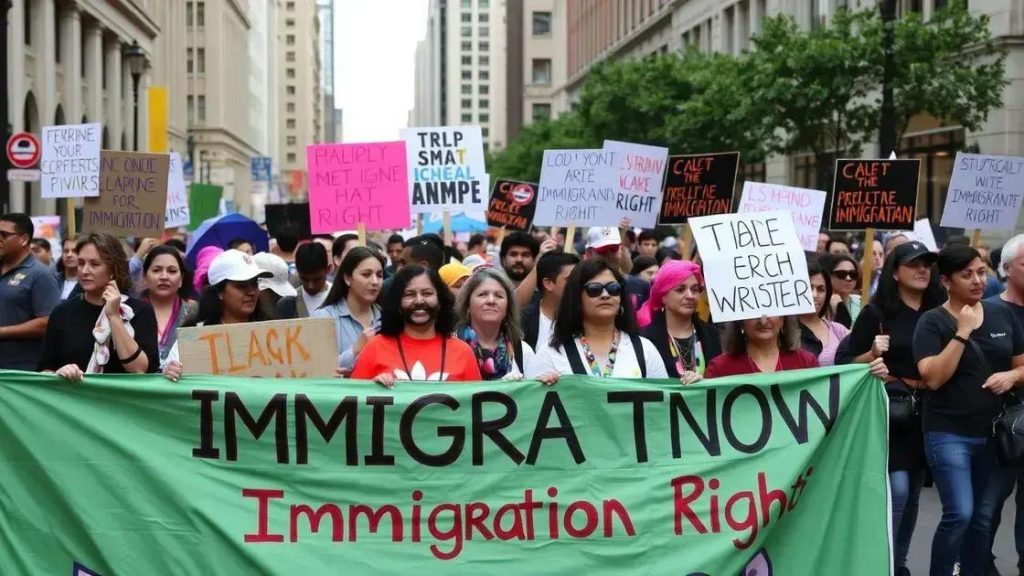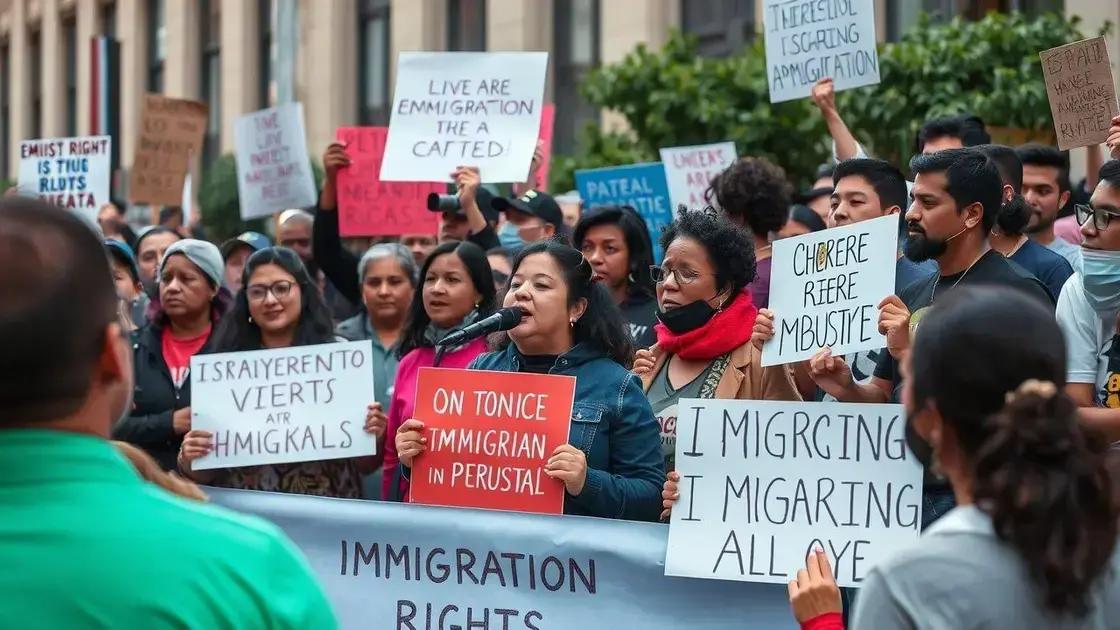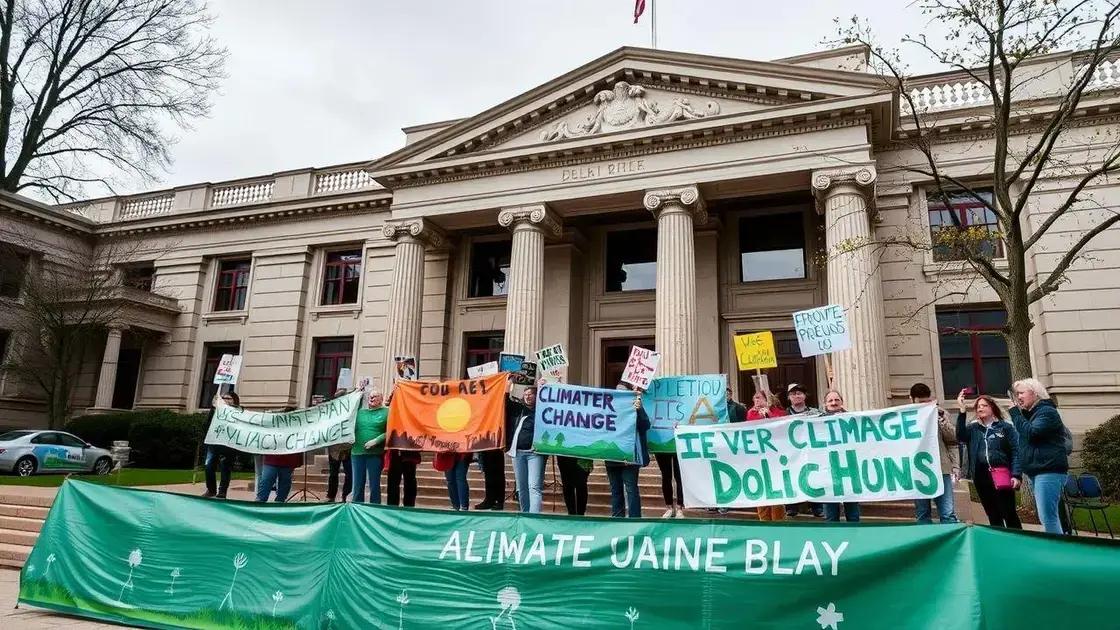Immigration rights demonstrations escalate in April 2025

Anúncios
Immigration rights demonstrations escalate in April 2025, driven by community activism and public demands for policy change, highlighting the need for comprehensive reform and engagement from government officials.
Immigration rights demonstrations escalate in April 2025, highlighting the ongoing struggle for justice and equality. These protests have captured the nation’s attention, driving discussions about policies and community impact. What do these events mean for the future?
Anúncios
Background on immigration rights in the U.S.
The background on immigration rights in the U.S. reveals a complex and evolving history. Over the years, these rights have shaped the lives of millions and have been the subject of significant legal and social changes.
In the early days, immigration laws were quite lenient, allowing many to seek refuge and a better life. However, as issues of national security arose, regulations tightened, leading to debates about fairness and justice.
Anúncios
Evolving Legislation
Throughout the years, various laws aimed to protect or restrict immigration rights have been enacted. Some notable legislation includes:
- The Immigration and Nationality Act of 1965, which ended racial quotas.
- The Immigration Reform and Control Act of 1986, which provided amnesty to millions.
- The Illegal Immigration Reform and Immigrant Responsibility Act of 1996, which increased penalties for illegal immigration.
These laws have had a lasting impact on communities and the perception of immigrants in society. Many activists argue that immigration rights should ensure fair treatment and opportunities, regardless of one’s status.
The debate continues today, with many advocating for comprehensive reform that respects the dignity of all individuals. As the landscape of immigration rights evolves, public opinion shifts, influenced by social movements and government policies.
The Role of Activism
Activism plays a crucial role in shaping immigration policy. Grassroots organizations advocate for justice, using protests, legal challenges, and public education to raise awareness.
Key topics that often arise in these discussions include:
- Access to legal representation.
- Protection of vulnerable populations.
- Pathways to citizenship.
Through ongoing efforts, activists strive to create an environment where all individuals feel safe and valued, regardless of their immigration status.
Key events fueling current demonstrations
The key events fueling current demonstrations around immigration rights have ignited a passionate response across the United States. Recent political decisions and societal changes have sparked public outrage and mobilization.
One significant event occurred when a new policy proposed stricter border controls. This announcement led to protests in major cities, as many viewed these measures as oppressive and unjust. Activists quickly organized rallies to voice their disapproval.
Rise in Community Organizing
In response to governmental changes, community organizing has gained momentum. Many grassroots organizations are stepping up to lead the charge for justice and equality. They play a critical role in bringing people together to advocate for immigration rights.
As organizations grow, they often focus on specific issues, such as:
- Opposing family separations at the border.
- Fighting deportation of longstanding residents.
- Advocating for pathways to citizenship.
This community-driven support has energized younger generations and empowered individuals to speak out against injustices.
Another pivotal moment was the amplification of personal stories through social media. These narratives help humanize the struggle for immigration rights and connect individuals on a deeper level. Videos and posts of affected families have gone viral, drawing attention to the realities many face.
National Events and Solidarity
National events, such as marches and solidarity rallies, play an essential role in demonstrating unity. These gatherings showcase diverse groups coming together to demand change. They serve as a reminder that the fight for rights is a shared struggle.
Across the nation, communities are resonating with the calls for justice, demonstrating that the pursuit of immigration rights transcends individual borders. As cities host more rallies, they become symbols of resistance against discrimination.
Voices of activists and community leaders

The voices of activists and community leaders are crucial in the fight for immigration rights. These individuals often lead the charge, advocating for change and representing the perspectives of those affected by immigration policies.
Activists come from diverse backgrounds and experiences, which enrich their efforts. Their personal narratives often resonate with people in the community, making the cause more relatable and urgent. Many activists share their stories through social media, creating a powerful platform to reach larger audiences.
Community Leaders and Their Impact
Community leaders play a significant role in organizing efforts. They help connect various groups, fostering collaboration and unity among activists. These leaders often have established trust within their communities, which can inspire more people to join the movement. Key contributions from community leaders include:
- Organizing local events and rallies.
- Providing resources and information about immigration rights.
- Building coalitions with other social justice movements.
Their work enables communities to come together and amplify their voices in wider discussions. The more they collaborate, the greater the impact on public perception and policy changes.
Another important aspect is the power of storytelling. Activists share personal experiences to emphasize the human side of immigration issues. These narratives can evoke empathy and drive action, encouraging more citizens to engage with the cause.
A Diverse Movement
This movement comprises individuals from various ethnicities and socioeconomic backgrounds. Each activist adds a unique perspective, making the fight for immigration rights more inclusive. The diversity ensures that many voices are heard, creating a richer conversation around the challenges faced by immigrant communities.
Through public speaking, social media campaigns, and participation in local government, activists consistently remind society that immigration rights matter. Their dedication often inspires younger activists to step up and continue the legacy of advocacy.
Government response to the escalating protests
The government response to the escalating protests surrounding immigration rights has been complex and often controversial. As demonstrations grow, officials face increasing pressure to address the concerns raised by activists and community members.
Recent protests sparked by proposed immigration policies have led to a range of responses from government officials. Some leaders have expressed willingness to listen and engage with protestors, while others have taken a more defensive stance.
Statements from Officials
In public addresses, some officials have acknowledged the importance of addressing immigration rights. They emphasize the need for dialogue and understanding. However, contrasting views exist, often leading to heated debates. Key points from government responses include:
- Calls for comprehensive immigration reform.
- Statements that maintain border security is essential.
- Reassurances that the government values human rights.
The differing messages can confuse the public, leading to frustration among activists who seek clear action instead of vague promises.
Public sentiment around these protests plays a significant role in shaping government actions. As more citizens join the cause, officials may find it necessary to adapt their stance to reflect the community’s concerns. Grassroots movements can create pressure that cannot be ignored, making dialogue crucial.
Legislative Actions
In some cases, governments have taken steps to introduce new legislation aimed at addressing the root causes of the protests. Proposed bills often aim to:
- Provide pathways to citizenship for undocumented individuals.
- Increase funding for legal support for immigrants.
- Enhance protections for families at risk of separation.
Such initiatives can represent progress, yet implementations may still face challenges. Implementation often meets resistance from various political factions, highlighting the ongoing conflict over immigration issues.
Media coverage of these responses also plays a vital role. Reports that focus on both government actions and protestors’ experiences can influence public perception, potentially swaying more citizens to join the movement for immigration rights.
Impact on public policy and future actions
The impact on public policy and future actions related to immigration rights is significant, especially in light of recent demonstrations. As communities unite to demand change, policymakers must respond to the growing calls for justice and equality.
Protests have highlighted critical issues such as family separations, access to legal resources, and fair treatment under the law. These topics have gained traction, influencing the priorities of lawmakers across the nation.
Shifts in Legislative Focus
As public awareness increases, legislators are beginning to address immigration with renewed urgency. This shift can lead to the introduction of new policies or amendments to existing laws. Some promising areas of focus include:
- Creating pathways to citizenship for undocumented individuals.
- Enhancing protections for vulnerable immigrant families.
- Investing in community education about legal rights.
Such initiatives could represent significant progress in the pursuit of immigration rights and reflect the values of a growing movement.
In addition to new legislation, public pressure may influence how current laws are enforced. For instance, local jurisdictions might adopt more humane practices and seek to prevent unnecessary deportations.
Engagement with Communities
Policymakers are increasingly recognizing the need to engage with immigrant communities directly. This engagement allows lawmakers to understand the lived experiences of individuals affected by immigration laws. Dialogue between officials and community leaders can foster collaborative solutions that prioritize human rights.
Importantly, as demonstrations continue, local and federal governments may be compelled to rethink their strategies. The response to protests is not only about policy changes but also about building trust. Reassuring communities that their voices matter can help bridge gaps between lawmakers and citizens.
Future actions will depend on the continued mobilization of activists. The ongoing pressure from grassroots organizations and community coalitions will be essential in holding officials accountable for their promises. As engagement increases, the hope for comprehensive immigration reform becomes more attainable.





